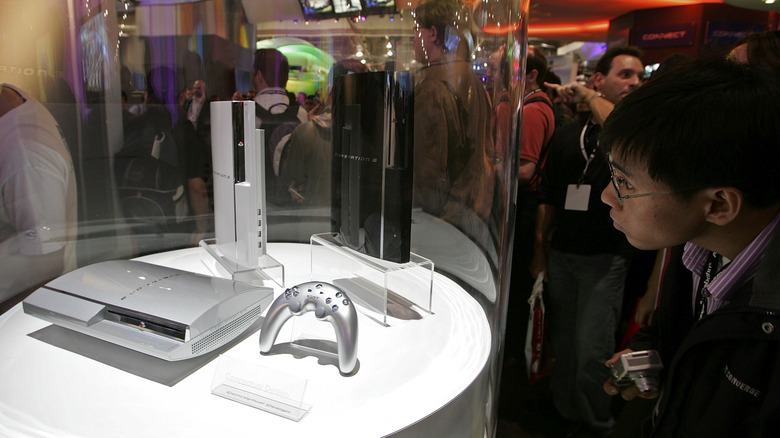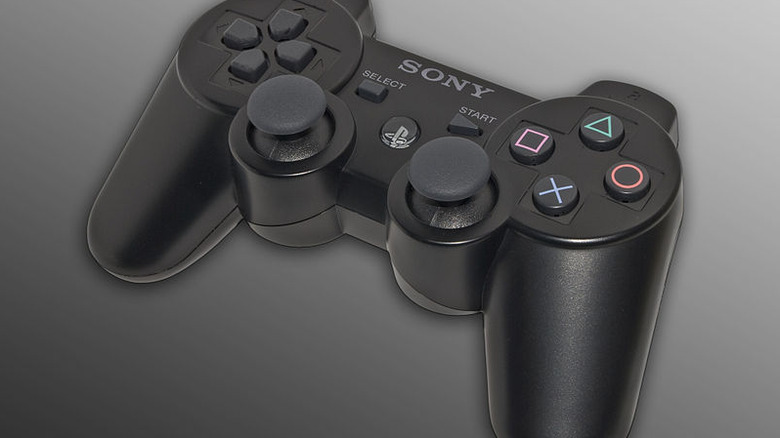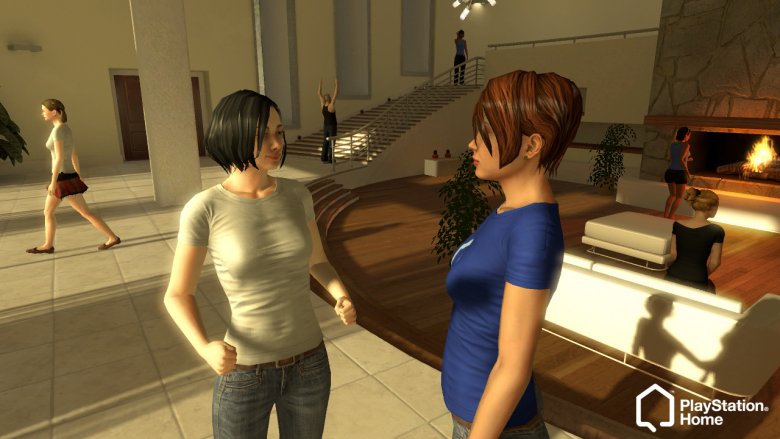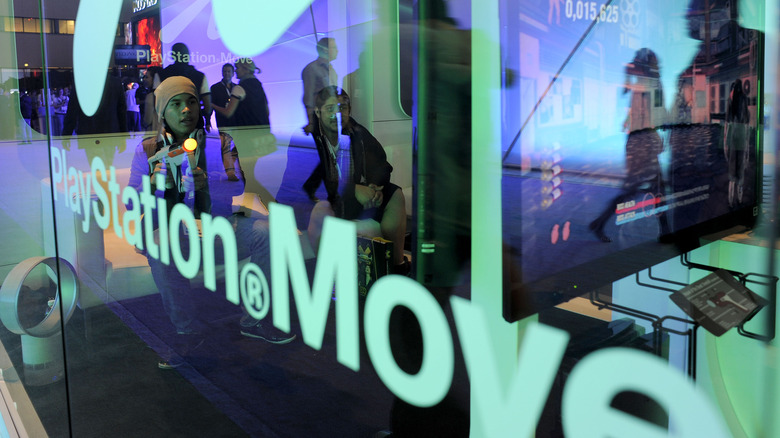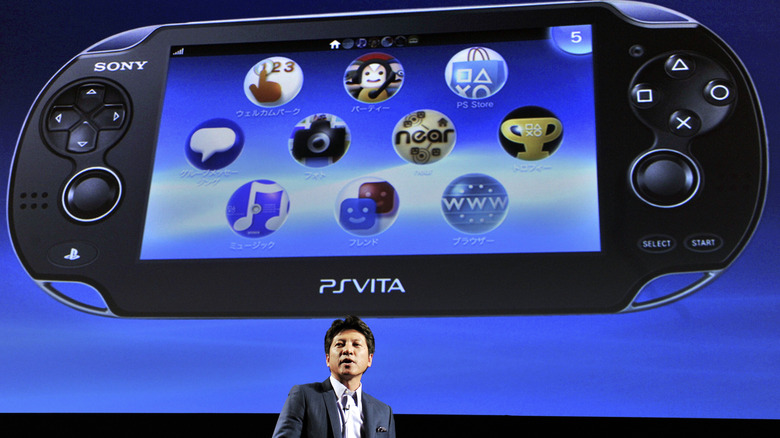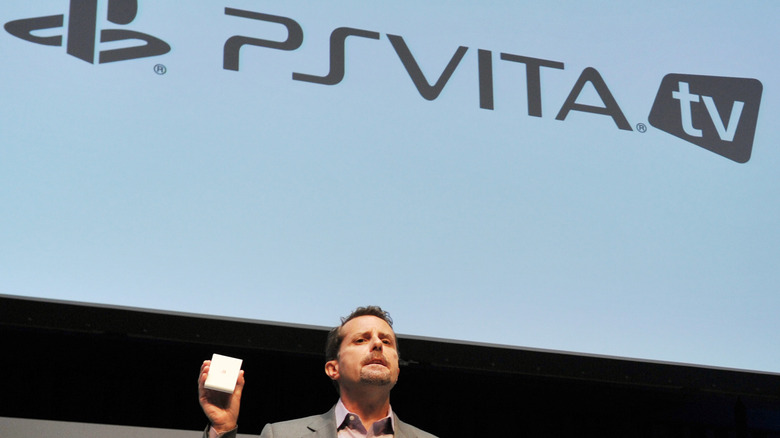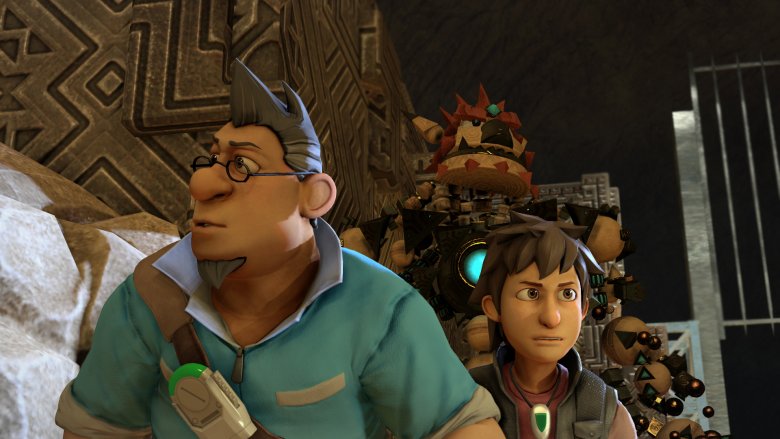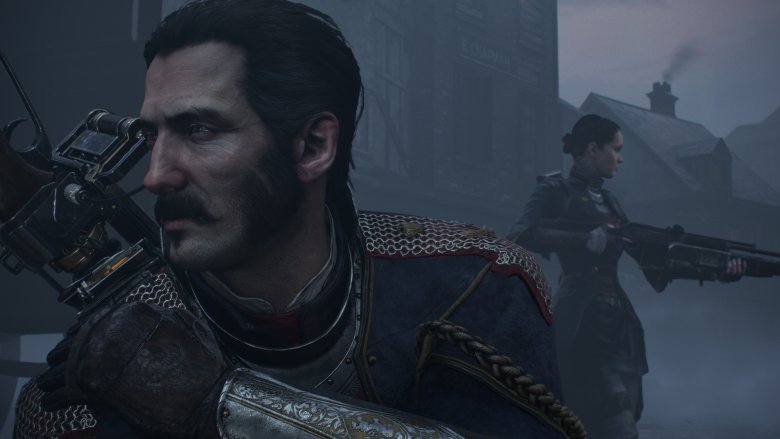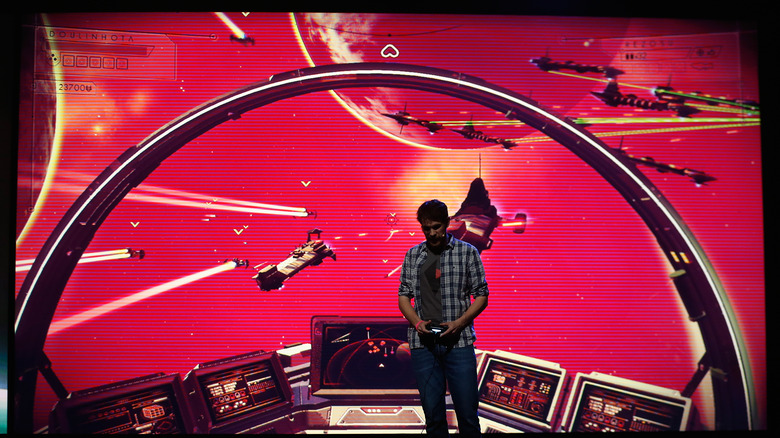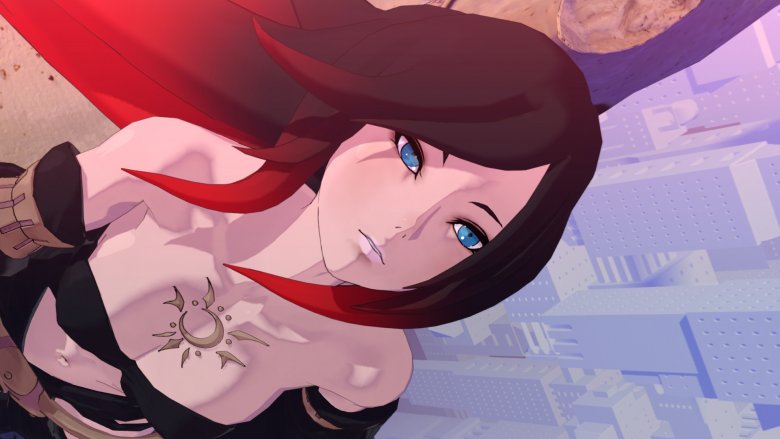Gaming Flops Sony Was Sure Would Be A Hit
In the early '90s, when Nintendo and Sega ruled supreme, it was tough to imagine that another company could come along and not only have an impact in the gaming industry, but eventually lead it. So goes the story of Sony, whose PlayStation console took the world by storm in 1994, and whose subsequent installments — the PlayStation 2, PlayStation 3, and PlayStation 4 — either won their respective generations or at least put up a good fight.
But not every decision has been a winner for Sony. Despite a decades-long history of producing great games and great systems, there have been a few stumbles along the way. Some hardware-related gambles haven't quite paid off. Choices made on details like pricing have negatively impacted what could been successful product launches. And several games haven't been as well received as Sony anticipated, leading to either disappointing sales or disappointed customers.
Here are a few of these flops — rare missteps by Sony in what is otherwise a successful run in the world of video games.
The PlayStation 3 Reveal
In 2006, Sony was on top of the world. The company was about to unveil its follow-up home console to the PlayStation 2, the best-selling console of all time. And it was confident this new system, the PlayStation 3, would offer a better value proposition than Microsoft's Xbox 360, which was released in the previous year. The PlayStation 3 would not only play the newest titles, but would also offer PlayStation 2 backwards compatibility, along with support for Blu-Ray movies.
The problem? The PlayStation 3's price tag. When Sony pulled back the curtain on the PS3, it announced there would be two versions of the console: a stripped-down $499 model, and a model with more desirable perks — like a larger hard drive and WiFi support — for $599. Both were priced higher than even the most expensive Xbox 360 model ($399), which stunned both fans and analysts. Following the event, analyst P.J. McNealy of American Technology research stated: "I think some people are going to find $599 intimidating – maybe not early adopters, but definitely the mainstream audience."
The price hurt PlayStation 3 sales, and Sony wound up dropping the price of the console twice — from $599 to $499, and then from $499 to $399 — before it reached a point where it could be competitive with the Xbox 360. And even by that point, the Nintendo Wii was running away with the generation.
The Sixaxis Controller
Sony almost made a mistake right out of the gate with the PlayStation 3 controller. At E3 in 2005, the controller on display for the console was a boomerang-shaped contraption. Fortunately, Sony decided to stick to the tried-and-true shape used by all of its previous controller designs, and gamers breathed a sigh of relief. That is, until they picked up its replacement, the Sixaxis.
Sony brought the Sixaxis to E3 2006, and the differences between it and the PS2's DualShock 2 controller were immediately evident. For starters, the Sixaxis felt much lighter. Those who used the controller learned this was because the rumble functionality found in previous controllers had been removed. The Sixaxis also included an integrated gyroscope, which made motion control possible.
Gamers were understandably disappointed about the lack of rumble in the Sixaxis, and Sony initially gave two excuses for the omission. The first was that the rumble would disrupt the gyroscope within the controller. Later on, Sony's Phil Harrison also defended the move by stating, "Now, rumble, I think was the last-generation feature; it's not the next-generation feature." Yes, rumble, which — to this day — we still have in every first-party controller, was a "last-generation feature."
Which excuse is the actual, real reason for the lack of rumble in the Sixaxis? As it turns out, it could be neither. Sony at the time was stuck in a protracted legal dispute with a company called Immersion, which held the patent for haptic feedback. Once Sony and Immersion settled in 2007, Sony moved to introduce the DualShock 3 early the next year. The Sixaxis was later discontinued.
PlayStation Home
Second Life launched for the PC in 2003, but for many years afterward, video game consoles lacked a similar piece of software. There was no virtual world to roam on your home system that invited you to simply live a, well, second life. Online games came with objectives: complete this mission, slay this beast, shoot that enemy, and so on. A place to hang out and make a polygonal home just didn't exist in the console market.
That all changed with PlayStation Home, which was announced in 2007 and launched on the PlayStation 3 in 2008. PlayStation Home promised to bring a Second Life-esque experience to consoles, complete with customizable avatars, virtual abodes, and ways to interact with all the other inhabitants of Sony's online universe.
It didn't work out. That's not to say PlayStation Home was an immediate failure — it didn't close up shop until March 31, 2015 — but it never took off in the way Sony had hoped. What was meant to be a virtual world brimming with possibility simply became a microtransaction-fest, forcing users to pay up to get the customizations they wanted. And despite offering embedded games in PlayStation Home, it turned out gamers weren't looking to walk through a make-believe town square to play them, not when Xbox Live could get you into a game and party in just a few button presses.
PlayStation Move
Sony's entry into motion controls came in 2010 with the introduction of PlayStation Move. The name Move itself refers to the package of two controllers, which included both a navigation controller for one hand and a motion controller for the other, not unlike the setup employed by the Wiimote and its "Nunchuck" accessory. You may remember the PlayStation Move motion controller for the large, distinct orb on top of it, which was used by the PlayStation Eye camera for location tracking.
The PlayStation Move was pretty well received, with critics praising its accuracy and responsiveness. The problem with PlayStation Move, though, was with support. Because the Move was an add-on accessory and not a built-in experience, like motion controls were with the Wii, it didn't work out of the box with every game. Not many games were built specifically for it, and many games with Move support simply tacked on motion controls in an unsatisfying way. Sony copped to not providing enough unique experiences for the peripheral in 2012, and that support continued to fade as the company steamed full speed ahead toward the PlayStation 4.
The good news is, if you didn't sell your PlayStation Move at a yard sale, it's now useful again. Sony recycled the hardware for use with PlayStation VR, though a patent filed in early 2018 indicates Move's days may be numbered there, as well.
PlayStation Vita
Sony's first entry into the portable console market was a resounding success, with the PlayStation Portable selling over 76 million units. It's not surprising, then, that those who'd bought into Sony's first handheld effort would be anxiously awaiting its next. That wound up being the PlayStation Vita, which arrived in the United States in early 2012.
The PlayStation Vita had tons of promise. Reviewers of the portable loved its gorgeous OLED touchscreen display and its graphical prowess. The system boasted many fascinating features: online play via WiFi (or 3G in its early versions), a capacitive touchpad on the back of the Vita, and the promise of 3D triple-A titles on the go. And cross-play between the PS3 and Vita meant gamers could leave their consoles and pick right up on their portable if the game supported it.
Ultimately, the dream didn't live up to the reality. As with the aforementioned PlayStation Move, which also enjoyed a warm critical reception, Sony failed to support the Vita enough for it to reach its full potential. By the time the PlayStation 4 came around, the Vita became a cult-favorite for indie game fans, but failed to become the commercial success it was expected to be. Estimates have its install base at around 10 million units, a paltry sum compared to the PSP. And with the Switch taking over as the darling platform for indies (as well as major first-and-third-party titles), the Vita seems destined to fade into obscurity, with no signs Sony will give the handheld market another go.
PlayStation TV
Given Sony's underwhelming support for the PlayStation Vita, and the lackluster sales the portable posted as a result, Sony decided not to release any other Vita-related products in the United States... is what you'd expect to read. But that isn't the truth. Instead, Sony's North American arm decided to import a micro-console released in the Japanese market the prior year — Vita TV — and rebrand it. The PlayStation TV hit the shores of the United States in October 2014, and the $99 device soon began its journey toward bargain bins and clearance shelves nationwide.
The PlayStation TV wasn't a bad product. In fact, some outlets thought it was going to be a huge hit for Sony. But the PSTV's biggest feature — its ability to play Vita games on a larger screen — was hampered by the fact that the Vita wasn't all that popular. Other features later added to the PlayStation TV, such as PlayStation 4 remote play and PlayStation Now streaming support, weren't enticing enough to make the PSTV a must-have for gamers. And so the PlayStation TV ran out of gas before it could ever reach full speed.
Sales figures aren't known for the PlayStation TV, but Sony's treatment of the device seems to insinuate that the numbers weren't good: the device was dropped to $19.99 on Sony's store less than a year after launch, and was discontinued in North America shortly thereafter.
Knack
On paper, Knack should have been something special. The PlayStation 4 exclusive, released at the console's launch in November 2013, was the brainchild of vaunted game designer Mark Cerny, whose previous works included Crash Bandicoot, Spyro the Dragon, and Ratchet & Clank. And the game's unique premise — the character Knack is a being made of "Relics" who could shrink or grow depending on the number of Relics he was surrounded by — gave it a chance to stand out from the more traditional action and sports launch titles.
But Knack never quite lived up to expectations. The game received middling review scores, with critics singling out the game's story and unexpected difficulty as weak points. The game never managed to make much of an impact on the community, and it quickly fell out of the gaming conversation. In spite of the game being a perceived flop, however, Sony still went ahead with a sequel to Knack, which released in 2017. That game received better reviews.
The Order: 1886
At E3 2013, nearly half a year before the PlayStation 4 launched, Sony unveiled a game that looked like it could set an early high bar for graphics and cinematics. Titled The Order: 1886, the game promised to transport players into an alternate-history (but realistically laid out) London full of animal-human hybrids, steampunk-inspired weapons, and top-notch storytelling. Following that E3 event, The Order: 1886 became an eagerly anticipated release for many who planned to pick up a PlayStation 4 later in the year.
Unfortunately, The Order: 1886 disappointed fans before they could even get their hands on it. The game slipped out of its original 2014 release window, instead arriving in early 2015. And when it did finally launch, players were disappointed to find that the game was incredibly short, with its campaign clocking in at around six hours long. Reviewers also knocked the game's combat for being "generic," and while most did admit the game's art was fantastic, that art didn't make the game any less boring.
The Order turned out to be a critical failure. And we haven't heard a peep about a new game in the series since.
No Man's Sky
Prior to the PlayStation 4 generation, developer Hello Games was known for the Joe Danger series of games, which released across a variety of platforms. These featured racing and platforming elements inside side-scrolling levels, and weren't exactly the most complex games ever created. So when the VGX Awards rolled around in late 2013, and Hello Games unveiled No Man's Sky — an ambitious exploration game with a procedurally generated universe — it's safe to say a few eyebrows were raised.
If there were skeptics following No Man's Sky's announcement, they certainly didn't become any less skeptical in the years leading up to the game's release. NMS became the very definition of hype in the gaming world, and what made matters worse was the fact that Hello Games' Sean Murray, the lead director on the project, was feeding the frenzy, going so far as to appear on The Late Show with Stephen Colbert to demo the title. As the buzz grew and Hello Games needed some more experienced help, Sony stepped in to handle distribution.
But when the game released in summer 2016, fans and critics alike found that it was missing many of its advertised features. Further, the procedurally generated worlds shown in marketing materials turned out to be far less exciting in the final product. And the final nail in the coffin? After the many faults of No Man's Sky became apparent, Hello Games essentially stopped communicating with customers for months. No Man's Sky wound up building a universe full of broken promises.
Gravity Rush 2
In 2012, the original Gravity Rush released on the PlayStation Vita to generally favorable reviews and, in spite of its platform, surprisingly decent sales. But if you've read through the list so far, you're aware of the direction the Vita went later on. So it makes sense that next title would not come out for the handheld. Instead, Gravity Rush 2 landed on the PlayStation 4, giving console players a chance to experience the anime-style action/adventure game on a much larger screen.
At first, things looked promising. Gravity Rush 2 released in January 2017 — and had a relatively good first week of sales in Japan. But the game's appeal in the West was limited, and even Japanese interest in the title started to trail off after a few weeks. Sales aside, the game received positive reviews across the board, but it didn't seem to generate the desired amount of buzz, despite the fact the original Gravity Rush had been remastered and released on the PlayStation 4 a year earlier.
Sony moved to shut down Gravity Rush 2's servers only a year after its release. Fans of the game petitioned the company to keep the servers online, and Sony acquiesced — to a point. Instead of closing up shop in January 2018 as was planned, Gravity Rush 2's servers were scheduled to remain online until July 2018.
But the damage, it appears, has been done. Given the underwhelming response to the game, and the quick server shutdown, a sequel doesn't look all that likely.

